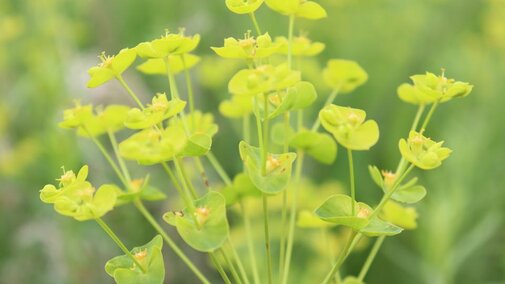Leafy Spurge Control
Yellow-green patches in a pasture might look pretty for the uninitiated, but the telltale bloom of leafy spurge is not a spring sight many of us want to see.
While there are many plants livestock producers may consider pasture weeds, one that is held in particular dislike is leafy spurge. Besides being on the Nebraska noxious weed list and requiring control, this hardy perennial spreads aggressively through seeds and root buds. With an extensive root system that can reach depths up to 15 feet, spurge is hard to control once established.
While biological and cultural control methods may provide some reduction in growth and seed production, those wanting complete control might consider an herbicide treatment as the best option.
Multiple chemicals have action on spurge; however, for spring treatments, control at bud or true flower stage is recommended. Options for application at the bud stage are 2,4-D ester (4L) , Graslan L®, Tordon 22K®, or Picloram 22K. If applying a bit later at flower stage options include Curtail®/Cody®/Stinger®, Streamline®, an Overdrive® + Tordon 22K® mix, or a Sharpen® + Plateau® mix.
Unfortunately, a single treatment will not control spurge, so continued monitoring and retreatment is necessary. An effective strategy is pairing spring applications that prevent seed production with a fall treatment to control new growth.
Leafy spurge can easily take over a pasture, but with vigilance and regular treatment, control can be achieved.
Alfalfa Weevil Update
Alfalfa weevil continues to be an issue this year, with recent population peaks and feeding damage observed in central Nebraska. Nebraska Extension urges alfalfa producers — particularly in central and western Nebraska — to scout for this pest.
Plant injury from alfalfa weevil feeding damage appears as pinholes in the terminal leaves, with leaves becoming skeletonized and fields appearing droughty as feeding severity increases. Larvae are 1.5 mm to 8.5 mm long with a black head, wrinkled green body and white stripe along the back, and will curl into a C-shape when disturbed.
Scouting for alfalfa weevil is simple and can mitigate yield losses due to feeding damage. First, use a sweep net to determine whether larvae are present. If they are, randomly select five sites across the field and collect 10 stems at each site, cutting the stems at ground level. Beat the stems into a deep-sided bucket, count the total number of larvae, and divide by 10 to determine the average number of larvae per stem.
Economic thresholds for alfalfa weevil can vary greatly from an average of 1-7 larvae per stem, depending on a variety of factors. Threshold tables can be found on the CropWatch website. If very small larvae are found before the first cutting, it is recommended that the field be scouted after cutting to check for feeding on regrowth.
While there are several insecticides labeled for alfalfa weevil management, there have been reports of some products not performing as well as expected. Therefore, if you believe you have an infestation above threshold, contact your county extension office for further guidance.
Planting Warm-season Annuals
Warm-season annuals or summer annual grasses such as sorghum, sudangrass and sorghum-sudangrass hybrids grow best in Nebraska when soil temperatures are about 60°F (usually in late May to early June). In contrast, pearl millet, foxtail millet and teff grass seeding dates are usually delayed until June or possibly July when soil temperatures are consistently above 65 degrees.
Summer annual grasses can provide alternative forage when pasture grasses are in short supply. Annual forages provide flexibility harvested as green chop, hay or silage, as well as grazed in summer or winter.
Decisions regarding when to best plant warm-season annuals may depend on planned use. Planting dates may be staggered to complement a rotational grazing system. Or, if winter pasture forage supplements are needed; then planting may be delayed into early August. However, adjust planting dates for rotational grazing to allow at least six weeks of forage growth prior to grazing.
If your goal is producing high biomass tonnage, then plant sorghum-sudangrass hybrids earlier for haying or green chop. Whereas, if forage grazing quality is your goal, then sudangrass may be chosen due to thinner stems and more rapid regrowth.
For drought tolerance and reduced risk of prussic acid and nitrate poisoning risk, planting pearl millet and teff may be your pick. However, these species produce about 30% less tonnage compared to growing sudangrass and/or forage sorghums.
Foxtail millet may also be used as a short-season summer annual on sandy soils. However, this species can host curl mites that vector wheat streak mosaic virus into neighboring wheat fields. So, limit warm-season annual foxtail millet planting near grain-producing wheat fields.

